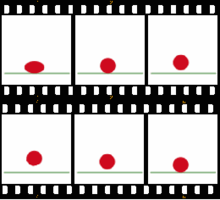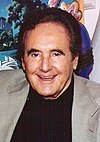Portal:Animation

| Main | Categories and topics | Tasks and projects |
Introduction
Animation is a filmmaking technique by which still images are manipulated to create moving images. In traditional animation, images are drawn or painted by hand on transparent celluloid sheets (cels) to be photographed and exhibited on film. Animation has been recognized as an artistic medium, specifically within the entertainment industry. Many animations are computer animations made with computer-generated imagery (CGI). Stop motion animation, in particular claymation, has continued to exist alongside these other forms.
Animation is contrasted with live-action film, although the two do not exist in isolation. Many moviemakers have produced films that are a hybrid of the two. As CGI increasingly approximates photographic imagery, filmmakers can easily composite 3D animations into their film rather than using practical effects for showy visual effects (VFX). (Full article...)
Selected article
Aang is a fictional character in Nickelodeon's animated television series Avatar: The Last Airbender. The character is created by Michael Dante DiMartino and Bryan Konietzko (pictured) and is voiced by Zach Tyler Eisen. Aang is depicted as the show's main protagonist, and as such has appeared in all but one episode of the show, the exception being "Zuko Alone". Aang also appeared in the pilot episode which has not been aired. Most of Aang's traits, such as vegetarianism, are based on Buddhist and Taoist tradition. Aang is the series' reluctant hero, showing hesitation when joining his friends to save the world from the Fire Nation. The series depict Aang as the last surviving Airbender and a monk of the Air Nomads, the only race of people with the unique ability to manipulate the air around them. As the Avatar, Aang has the ability to control the four classical elements and is tasked with keeping the Four Nations at peace. The show follows Aang's journeys to complete this task, during a war instigated by the Fire Nation when he was frozen. Aang is also depicted as having a lighthearted personality which has been accepted well among critics.
Selected image
Did you know (auto-generated) -

- ... that the stylized animation of Teenage Mutant Ninja Turtles: Mutant Mayhem was inspired by rough sketches in school notebooks?
- ... that according to an elaborate 1990s joke, Elmo Aardvark was history's first animated cartoon character?
- ... that Encanto's Isabela Madrigal was animated to be aware that she is "always on stage"?
- ... that Raoul Servais invented a new technique for combining animation and live action for his short film Harpya?
- ... that the interactive cartoon Cat Burglar takes about 15 minutes to watch, but features 90 minutes of animation?
- ... that although Blizzard's franchise Overwatch is centered around video games, its lore is mainly told through animated shorts, comics, and novels?
Selected quote
Selected biography
Joseph Roland "Joe" Barbera (March 24, 1911 – December 18, 2006) was an influential American animator, film director, film producer, storyboard artist, and cartoon artist. Born in New York City, after working odd jobs and as a banker, Barbera joined Van Beuren Studios in 1932 and subsequently Terrytoons in 1936. He met his lifelong collaborator William Hanna while working for Metro-Goldwyn-Mayer in 1937 and soon began producing animated shorts such as the Tom and Jerry series. In 1957, after MGM dissolved their animation department, they co-founded Hanna-Barbera, which became the most successful television animation studio in the business, producing programs such as The Flintstones, The Huckleberry Hound Show, Top Cat, The Jetsons, Scooby-Doo, The Quick Draw McGraw Show, The Smurfs, Wacky Races and Yogi Bear. Hanna and Barbera won seven Academy Awards and eight Emmy Awards. Their shows, which have translations in more than 20 languages, had a global audience in the 1960s of over 300 million people.
Selected list
The Annie Award for Best Animated Video Game is awarded annually by ASIFA-Hollywood, a non-profit organization that honors contributions to animation, to the best animated video game of the year. It is one of the Annie Awards, which are given to the best contributions to animation, including producers, directors, and voice actors. The Annie Award for Best Animated Video Game was created in 2005, and has been awarded yearly since. To be eligible for the award, the game must have been released in the year before the next Annie Awards ceremony, and the developers of the game must send a five-minute DVD that shows the gameplay and graphics of the game to a committee appointed by the Board of Directors of ASIFA-Hollywood. As of 2011, the Annie Award for Best Animated Video Game has been awarded to five video games. The video game development company THQ has had six of its games nominated for the Annie Award for Best Animated Video Game, and one of them, Ratatouille, has won the award.
More did you know...
- ...that the animated short film Sex Life of Robots, showing sexual activity among robots, is described as "art-porn"?
- ...that the donkey character Rucio in the 2007 children's film Donkey Xote, executive-produced by Giulia Marletta (pictured), was made to look like "Donkey" from Shrek?
- ...that Ed, Edd n Eddy's TV movie series finale, Ed, Edd n Eddy's Big Picture Show, premiered on November 8, 2009, and achieved high ratings success for Cartoon Network?
Anniversaries for May 10
- Films released
- 1929 - Gold Socks (United States)
- 1941 - Farm Frolics (United States)
- 1946 - In Dutch (United States)
- 1947 - Rabbit Transit (United States)
- 1952 - Sock-a-Doodle-Do (United States)
- 1958 - Feather Bluster (United States)
- Television series and specials
- 2009 - Snake 'n' Bacon, an American animated television pilot airs on Cartoon Network's Adult Swim block
Subportals
Related portals
Wikimedia
The following Wikimedia Foundation sister projects provide more on this subject:
-
Commons
Free media repository -
Wikibooks
Free textbooks and manuals -
Wikidata
Free knowledge base -
Wikinews
Free-content news -
Wikiquote
Collection of quotations -
Wikisource
Free-content library -
Wikiversity
Free learning tools -
Wiktionary
Dictionary and thesaurus


























